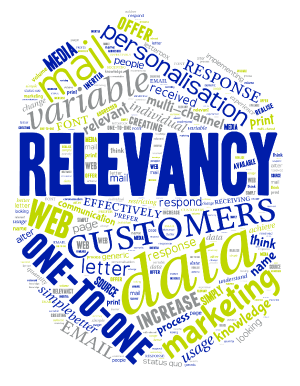True One-to-One Marketing Can Be a Reality, Not Just a Goal.
It’s All About Relevancy!
Too many companies are still restricting their marketing efforts to generic or simple personalisation.
Often, this is due to a failure to understand the potential inherent in their knowledge of their customer’s data. Sometimes it’s just inertia.
 Many don’t realise that they could dramatically increase their response rates and reduce their volumes by spending more time at the front end of the process creating communications that are more relevant to the individual recipients.
Many don’t realise that they could dramatically increase their response rates and reduce their volumes by spending more time at the front end of the process creating communications that are more relevant to the individual recipients.
The younger generations are re-embracing print & mail; as long as it’s personalised and relevant. Many no longer use email for anything they don’t have to, preferring social media channels. Most however love receiving a letter in the letterbox...but only respond if it is relevant to them. The amount of customer data and usage patterns available today leave companies with no excuses for not communicating one-to-one. It’s all about relevancy, and relevancy is achieved by using data effectively.
With the rapidly changing landscape of the printing industry, many Print Service Providers are spending a lot of time effort and money on keeping the business they have, as well as getting more customers for their existing services. It’s not news that to keep up with demand, a lot have added digital printers to their production environment to help facilitate more cost effective shorter runs. Those that are looking at the next step forward have also added data driven personalisation capabilities, however, is the output as relevant – and therefore as valuable – as it could be? How are you going to expand your offerings in 2014?
I recently discussed this issue with Australian business leader and all round nice guy Howard McDonald. Mr McDonald is current Chairman of Rodd & Gunn, previous Chairman of Myer Holdings Limited, and former Managing Director of Just Group. He agreed, that; “absolutely, nobody wants to receive an offer for something they already have or don’t need.”
We continued about the fact that today we have the data, so it “all should be about one-to-one marketing” he went on to say, and that “too many companies don’t seem to think about all of the data they already have about their customers.”
I agree with Mr McDonald’s sentiments 100% and I think that the two biggest issues are:
- Status quo – “that’s the way we’ve always done it” and the perception that the financial and time cost of change to do anything differently will be too great.
- Lack of knowledge and experience – I am still amazed when I review with senior people some of the levels of personalisation that we were achieving 10 or even 20+ years ago, and get back, “really, you can do that?”
Yes, simply by using the data you already have about your customers more effectively, you can make every object or component of a document variable. Feasibly, every piece of every page of every document could be variable, whether the run is hundreds, thousands, hundreds of thousands or more.
We’ve all received the generic letter with a “Dear Sir/Madam”. It may have been addressed to your house, but no personalisation. We may have even received a letter or DM piece that has some good use of our name in some fancy font, yet is trying to sell us something that we’ve already bought, or something they should know we don’t need.
This opens up several opportunities for PSPs. They can expand their existing in house capabilities by educating or recruiting. Alternatively they can look at strategic partnering. Just as PSPs are experts in their field of print, mail houses and print and mail service bureaus are experts in data and mail.
 My advice would be to explore partnership opportunities with complementary businesses in your local area. Obviously, keeping costs down and profits up is important, However, enabling your business to better and more completely service your customers – with the right products & services, turnarounds, and costs – is what ensures ongoing profitability.
My advice would be to explore partnership opportunities with complementary businesses in your local area. Obviously, keeping costs down and profits up is important, However, enabling your business to better and more completely service your customers – with the right products & services, turnarounds, and costs – is what ensures ongoing profitability.
Print isn’t the only way for you to expand your offerings in this area of personalised customer communication. Gone are the days of single channel communication with your customers and your customers’ customers. Rather than simply getting more quantity in a run, focus on getting more quality and relevant output, whether it is just print, or print supplemented by email or web-based communication.
Adding data preparation, postal sorting, business analysis and rule generation can create an additional revenue stream for you, and moreover usually creates more design work too. Instead of a single layout, you may now have the potential of removing components of text and incorporating data or calculated values instead. This in turn may also require generating different versions of particular document components that get variably pulled in on-the-fly throughout the run based on different conditions. When adding personalisation, you are not simply limited to presenting the data provided in the data file from the customer. You may be given name & address details, however can you extract the gender from that data? Can you pull the postal code or something else about their location? Do you have additional usage or profile data in the file that you could interrogate to add more relevance to the piece? And just because the customer didn’t supply specific data in the file, doesn’t mean it’s not available. Just like every new offering for your business, you need to look outside the square for additional opportunities.
It is important to realise that this is not only about technology and resource capability. Just like adding digital print to a commercial print shop for short run static, the sales processes and workflow requirements need to be modified to make personalised customer communication work effectively.
Whether we like it or not, much of the printing industry has been commoditised. Customer service, turnaround, and diversified offerings are how printers are keeping and getting customers. Adding digital capabilities was seen as a differentiator, enabling shorter runs and even quicker turnaround. Now that digital quality is arguably reaching or surpassing the quality of offset, even this is becoming a commodity in many sectors.
Incorporating data driven personalisation and variability can extend your service offering to give your customers greater value, and your business a new way of gaining revenue.
If companies have data about their customers, they need to use it effectively. If they don’t and can source it, they need to get it. If you don’t know how to get it for them, you should find out how.
One-to-one marketing is not just a goal that companies should aim towards, but a reality they should be implementing today. This creates a wonderful opportunity for PSPs to expand their business offerings and become more embedded within their customer’s business as a true partner.
It’s all about relevancy and that can be achieved for a lot less than you might think.
Do you have an example of good data use that shows greater than average relevancy?
Are you looking for ways to better utilise data about your customers or your customer’s customers?
About the author...
Brett Dashwood edp has decades of regional and global experience in the print & mail industry. He is the managing director of The Document Institute; an education and consulting company that helps businesses in and around the printing industry with their high volume data-driven document and postal solutions.

